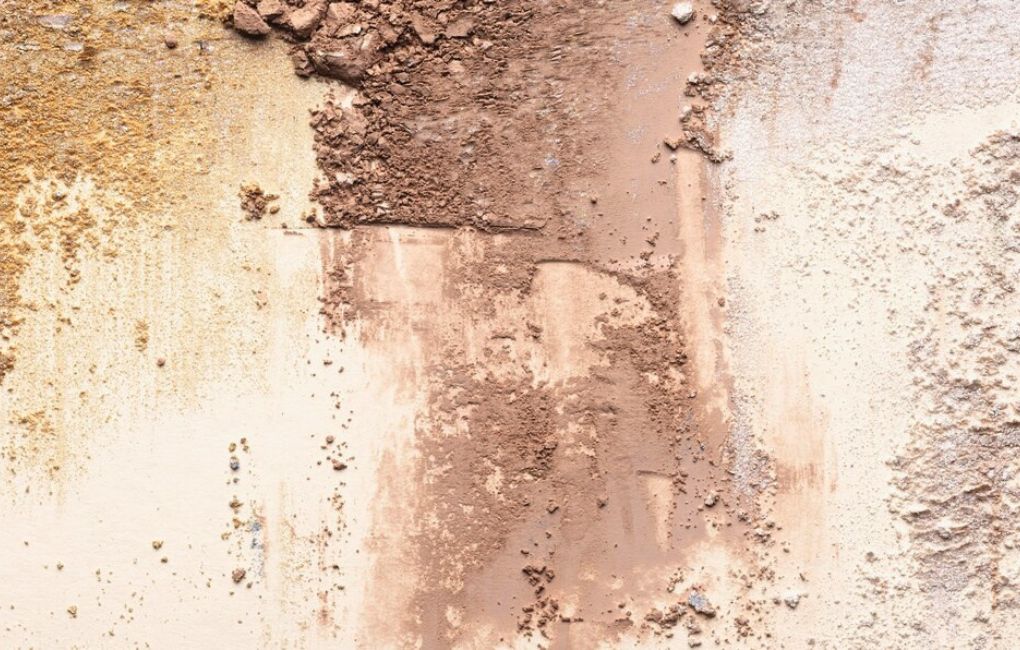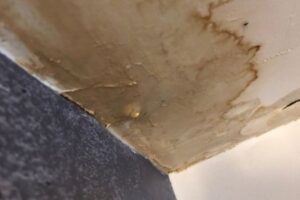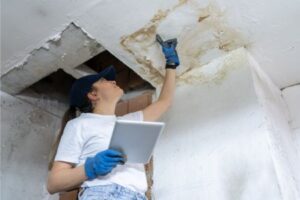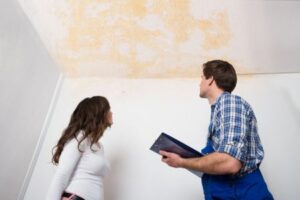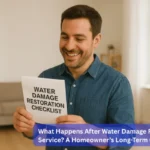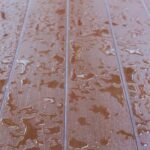Knowing how to tell if water damage is new or old is crucial for determining the proper response. New damage often appears brighter, with soft materials and noticeable moisture, while older damage shows darker stains, cracks, or signs of wear. Identifying these differences can help you decide whether immediate repairs are needed or if the issue is ongoing. For more practical tips on assessing water damage age, visit our blog.
Do you want to know how to tell if water damage is new or old? Let’s find out now!
Why It’s Important to Know the Age of Water Damage
Knowing the age of water damage is essential for several reasons. It affects your insurance claims and repair costs and can reveal potential health risks from prolonged exposure.
Insurance and Repair Cost Implications
The age of water damage plays a significant role in determining your insurance coverage and repair costs. New damage typically falls under the “sudden and accidental” category, which most insurance policies cover. Older damage may be seen as neglect, leading to possible claim denial.
Additionally, repair costs increase as damage ages, mainly if it affects the structure. Understanding the damage’s age helps you navigate your insurance policy and estimate repair expenses, ensuring you’re prepared for potential financial implications.
Health Risks from Long-Term Water Exposure
Water damage isn’t just about repair costs—long-term exposure can lead to serious health risks. Mold growth is common in older damage, causing respiratory issues, allergic reactions, or chronic illnesses. Stagnant water can also attract pests like insects or rodents, increasing the risk of disease.
Contaminants in the water, such as sewage, can cause infections if they come into contact with your skin. Identifying whether water damage is new or old helps assess the potential health dangers involved.
Damage Progression Over Time
Recognizing the age of water damage is crucial for understanding its progression. New damage often presents as wet spots or stains, while older damage may lead to mold growth, discoloration, or structural issues. The longer the water damage has been present, the more extensive the repairs may need to be.
For example, new damage can often be fixed with drying and sealing, while older damage may require professional mold remediation or structural repairs. Identifying the age helps you prioritize and plan effective restoration.
Water Damage Inspection – Signs of New Water Damage
Recognizing signs of new water damage is crucial for timely repairs. Understanding how to tell if water damage is new or old can help prevent further issues and guide your restoration efforts.
- Moist and Soft Wall or Ceiling Material: Moist or soft walls and ceilings are signs of new water damage. If materials feel spongy or have peeling paint, act quickly to find the water source and prevent further damage.
- Bright Stains or Bubbling Paint: Bright stains or bubbling paint suggest new water damage. These signs indicate moisture trapped beneath the surface. Immediate action is necessary to address the source and prevent worsening damage.
- Recent Musty Smell or Wet Odor: A musty or wet odor indicates recent water damage. This smell often indicates trapped moisture in materials like wood or drywall, which can lead to mold or mildew growth.
- Active Leaks or Dripping Water: Active leaks or dripping water indicate fresh water damage. Check areas around plumbing and appliances for leaks to prevent further damage. Prompt attention can help avoid costly repairs.
Water Damage Inspection – Signs of Old Water Damage
Understanding whether water damage is new or old is essential for timely repairs and preventing further deterioration. Here are some common signs that can help you distinguish between the two:
Darkened or Yellowed Water Stains
Dark or yellowed stains on walls or ceilings are usually signs of old water damage. The color suggests that the water has been present for a while. These stains often appear darker, with irregular shapes, and may have mold or mildew around them, further indicating prolonged moisture exposure.
Warped Walls, Floors, or Ceilings
Warping in walls, floors, or ceilings often signals old water damage. This occurs when moisture has infiltrated and compromised the structure over time. If you notice sagging, buckling, or uneven surfaces, it’s likely from prolonged water exposure that wasn’t addressed, leading to deeper structural issues.
Dry but Cracked or Flaky Paint
Cracked, dry, or flaky paint is typically a sign of old water damage. Prolonged moisture exposure causes the paint to lose adhesion, leading to visible cracks and peeling. If the paint looks worn, even in a relatively new space, it’s a sign that water damage has been present for a while.
Mold Presence or Residue Around Edges
Mold around the edges of walls and ceilings indicates long-term moisture issues. Mold thrives in damp, humid conditions, and its presence suggests that water damage has persisted for an extended period. Dark, ingrained mold or a musty smell points to older water damage that needs professional attention.
How Professionals Identify the Timeline of Water Damage
Professionals utilize specialized tools and techniques to accurately determine the timeline for water damage, helping assess its severity and guiding appropriate repair solutions.
Moisture Meter Readings
A moisture meter is essential for water damage assessment, providing accurate moisture content readings in materials like drywall, wood, and concrete. High moisture levels in specific areas may indicate new damage, while consistent high readings across larger regions signal long-standing issues. By comparing these readings with known dry levels, professionals can determine whether the water damage is recent or has been present for some time.
Infrared Cameras and Thermal Imaging
Infrared cameras and thermal imaging technology are invaluable tools in assessing water damage. These tools detect temperature variations, revealing hidden moisture not visible through traditional inspection. Cooler areas often indicate trapped water, which helps professionals differentiate between new and old damage. Thermal imaging also enables noninvasive inspections, reducing repair costs while providing a clearer picture of the extent and timeline of moisture issues.
Inspection of Material Deterioration Patterns
Professionals analyze material deterioration patterns to assess the age of water damage. Wood may warp, drywall could bubble, and paint may peel, with different signs indicating new or ongoing damage. Mold growth, rust, and discoloration often point to older water issues, while fresh damage typically leaves wet, stained surfaces. By examining these patterns, professionals can accurately determine the timeline and extent of the damage.
What to Do Next if You Discover Water Damage
Discovering water damage in your home can be overwhelming, but knowing how to tell if water damage is new or old and taking immediate action is key. Here’s a list of steps to follow:
- Identify the Source: Determine whether the water is coming from a leaky pipe, roof, or appliance. Addressing the source helps prevent further damage.
- Turn Off the Water Supply: If a plumbing issue is the cause, turn off the water supply to stop additional water from entering your home.
- Assess the Extent of the Damage: Inspect walls, ceilings, and floors for signs of moisture or water stains. A moisture meter can help determine the affected areas.
- Dry the Area: Use fans and dehumidifiers to speed up drying. Remove soaked materials like carpets and insulation to prevent mold growth.
- Document the Damage: Take photos of the damage for insurance purposes. Contact your insurance provider to begin a claim.
- Watch for Mold: Monitor potential mold growth and further damage to ensure a safe living environment for your family.
Final Thoughts on Water Intrusion and Water Damage Inspection
Understanding whether water damage is new or old is essential for effective repairs, accurate insurance claims, and safeguarding your health. Fresh water damage often shows as soft, moist surfaces, bright stains, or bubbling paint, while older damage presents dark yellowed stains, mold, cracking, or warping.
Recognizing these signs early can help prevent costly structural issues, mold growth, and potential pest infestations. Insurance coverage also hinges on timing—most policies cover sudden damage but may deny claims if it appears to stem from long-term neglect. Professionals use tools like moisture meters and thermal imaging to assess the age and severity of water intrusion, ensuring precise evaluations.
Whether you’re dealing with a recent leak or uncovering years-old damage, knowing what to look for allows you to take the right next steps—whether that’s drying out materials or calling in mold remediation experts.
Do you think the damage is old, but not sure? Let our pros verify and recommend the right next steps for your home. Visit our blog now for expert tips, or contact our team for a professional inspection. We’ll help you determine the age of the damage and guide you toward the most effective solution—fast.
Frequently Asked Questions
1. Can Water Damage Be Hidden Behind Walls or Ceilings?
2. How Does Mold Growth Relate to the Age of Water Damage?
3. What Tools Do Professionals Use to Assess Water Damage?
4. Is It Possible for Old Water Damage to Smell?
5. Can DIY Methods Accurately Determine Water Damage Age?

